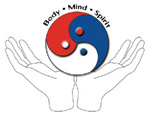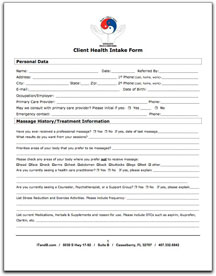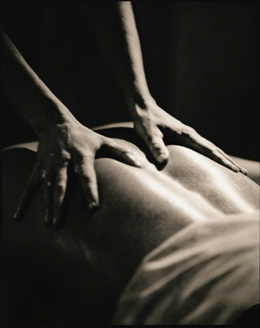|

|
Integrative Touch and Bodywork
Natural Pain Care
Through Massage Therapy
|
Before, during and after your Massage
Because massage is not a common part of our contemporary cultural experience,
many people feel uneasy about receiving their first massage. Here are a few
guidelines to help you feel at ease and to gain the greatest benefit from your
massage therapy session.
| Your LMT will review your Intake Form
and review any possible topics, medications, allergies, etc, that may require
modification of the massage session. There may also be a brief orthopedic
assessment of posture and specific joints.
The massage therapist will also
review the massage procedure, including how much to disrobe, positioning,
draping, etc.
The massage therapist will also answer any questions and attend to
any concerns the client may have. |
 |
 Tell the
therapist about areas of your body which are injured, tense or sore. Also
mention any medical conditions, such as; high blood pressure, heart problems,
chronic headaches, varicose veins, or any recent injuries or surgery. Tell the
therapist about areas of your body which are injured, tense or sore. Also
mention any medical conditions, such as; high blood pressure, heart problems,
chronic headaches, varicose veins, or any recent injuries or surgery.
 Close your eyes
and allow yourself to relax as completely as possible. Focus your attention on
your breathing, which should be slow, deep and even. Close your eyes
and allow yourself to relax as completely as possible. Focus your attention on
your breathing, which should be slow, deep and even.
 When the
therapist’s hands locate areas of pain or tension in the body, consciously try
to relax those areas. As you inhale deeply, visualize the breath flowing to the
tense area and relaxing it. As you fully exhale, visualize the tension leaving
the body with the breath. When the
therapist’s hands locate areas of pain or tension in the body, consciously try
to relax those areas. As you inhale deeply, visualize the breath flowing to the
tense area and relaxing it. As you fully exhale, visualize the tension leaving
the body with the breath.
 Conversation can
be distracting to you and the therapist. Good massage requires concentration on
the part of the therapist. Please limit your conversation to feedback about the
massage. However, feel free to speak up if anything the therapist does is too
painful, too ticklish, or uncomfortable in any way. Conversation can
be distracting to you and the therapist. Good massage requires concentration on
the part of the therapist. Please limit your conversation to feedback about the
massage. However, feel free to speak up if anything the therapist does is too
painful, too ticklish, or uncomfortable in any way.
 |
 Allow the
therapist to move your limbs into various positions. Be limp, like a rag doll,
and do not try to help move your arms, legs or head. The therapist is a trained
professional who will not do anything to hurt you. Allow the
therapist to move your limbs into various positions. Be limp, like a rag doll,
and do not try to help move your arms, legs or head. The therapist is a trained
professional who will not do anything to hurt you.
 The best way to
receive a massage is with the body completely unclothed. The therapist is
sensitive to your need for privacy and will keep your body covered with a sheet
or blanket, except for the area being massaged. If this arrangement is not
comfortable for you, you may wear underwear or swimsuit. The best way to
receive a massage is with the body completely unclothed. The therapist is
sensitive to your need for privacy and will keep your body covered with a sheet
or blanket, except for the area being massaged. If this arrangement is not
comfortable for you, you may wear underwear or swimsuit.
 Very often, as
the body releases tension during a massage, the mind will release emotion. If
you suddenly feel sad, angry or joyful, do not be alarmed. Allow yourself to
express these feelings by crying or laughing. At the very least, feel free to
sigh with relaxation or hum with pleasure. Very often, as
the body releases tension during a massage, the mind will release emotion. If
you suddenly feel sad, angry or joyful, do not be alarmed. Allow yourself to
express these feelings by crying or laughing. At the very least, feel free to
sigh with relaxation or hum with pleasure.
|
 Many people fall
asleep during a massage, an indication that the body and mind are releasing
stress and tension. The therapist will gently wake you when it is time to turn
over or to end the massage. Many people fall
asleep during a massage, an indication that the body and mind are releasing
stress and tension. The therapist will gently wake you when it is time to turn
over or to end the massage.
It is hoped that your massage is both enjoyable and beneficial, and that this
experience will be the beginning of a lifelong habit to help you enjoy the best
possible health and relaxation.
After your Massage
10 Steps to Physical Well-Being after Massage
 |
 Drink plenty of water for soft tissue irrigation; approx.
two (2) quarts of plain water. This will help flush your body of any
residual metabolites released during your treatment; such as lactic acid and
substance P which can cause soreness. Drink plenty of water for soft tissue irrigation; approx.
two (2) quarts of plain water. This will help flush your body of any
residual metabolites released during your treatment; such as lactic acid and
substance P which can cause soreness.
 Relax and stay warm. Do not do anything strenuous and go to
sleep early. Correct sleeping posture; on back, support under the knees, and
in neutral position. Relax and stay warm. Do not do anything strenuous and go to
sleep early. Correct sleeping posture; on back, support under the knees, and
in neutral position.
 Movement therapies; the following morning after the massage
do some general light stretching and go for a walk for 30 minutes in the
fresh air. Discipline yourself to have slower, smoother movements. Some
basic yoga postures would be ideal. Movement therapies; the following morning after the massage
do some general light stretching and go for a walk for 30 minutes in the
fresh air. Discipline yourself to have slower, smoother movements. Some
basic yoga postures would be ideal. |
|
 Soak in a hot bath (preferred over showering) for approx. 20
minutes or as long as you can stand it. Add Epsom salt or sea salt to help
with the extraction of toxins and wastes. Soak in a hot bath (preferred over showering) for approx. 20
minutes or as long as you can stand it. Add Epsom salt or sea salt to help
with the extraction of toxins and wastes.
 Ice packs on especially painful areas for up to 25 minutes
or until numbness is reached. Ice packs on especially painful areas for up to 25 minutes
or until numbness is reached.
 Postural awareness; 20 times a day, bring your attention to
the way you are sitting, standing, walking. If possible, use a 20 or 30
minute timer to freeze yourself and notice your posture and breathing
pattern. Take a moment to stand and stretch, then walk over and reset the
timer. Postural awareness; 20 times a day, bring your attention to
the way you are sitting, standing, walking. If possible, use a 20 or 30
minute timer to freeze yourself and notice your posture and breathing
pattern. Take a moment to stand and stretch, then walk over and reset the
timer. |
 |
 Decrease the intake of neuro stimulants such as caffeine and
sugar that will Decrease the intake of neuro stimulants such as caffeine and
sugar that will
increase pain.
 Breathing consciously and deeply several minutes a day in a
quiet, peaceful place will calm the sympathetic nervous system and decrease
pain. Breathing consciously and deeply several minutes a day in a
quiet, peaceful place will calm the sympathetic nervous system and decrease
pain.
 Have a positive attitude, be sensitive of others needs, and
empower those that are close to you. Have a positive attitude, be sensitive of others needs, and
empower those that are close to you.
 Love yourself
and be compassionate towards others Love yourself
and be compassionate towards others

Tedy Narvaez, LMT
|
